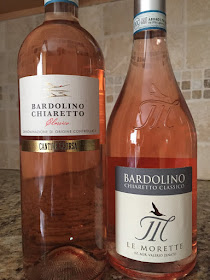The family members that shared their history of Montefioralle were Fernando Sieni, the father, and his son, Lorenzo, and daughter, Alessia. They were so dedicated to sharing their story with us that they did the video live from their vacation in Puglia with their kids playing in the background.
It's an important year for the Montefioralle winery as they are celebrating 50 harvests this October. The winery was founded by Fernando's father back in 1964. He rented the property and land from the church which he then planted the vineyards on. Fernando finally purchased it from the winery in the mid 90's. Both Fernando's parents were born in Montefioralle. Montefioralle was founded by German monks. Lorenzo mentioned that they found documents that actually mention that the priests of Montefioralle used to make wine in their vineyards all the way back to the 14th century.
The winery has come a long way from their 1st harvest of 500 liters to today producing about 10,000-12,000 bottles annually.Some of their procedures have changed over time where they used to use wooden barrels for fermentation where now they use cement vats. Fernando was the one whom started green harvesting at the winery where they discard some of the grape bunches to increase the quality of the grapes. His father was never in agreement of this as he thought it was always a waste of the grapes, until he really understood the reasoning behind it to produce higher quality wines. They are currently taking part in green harvesting as we speak. Lorenzo and Alessia's nephew, Sebastiano, whom is 12 has taken a liking to being in the winery and takes part in these activities including harvest.
The family shared that they have faced some difficult harvests like any winery including 2002 due to heavy rains where there many diseases evolved and the grape bunches had to be harvested by hand. 2014 was another difficult vintage where they lost over 40% of their production. As Lorenzo described though that a great winemaker is one whom can produce great wines in the bad years as opposed to the good. Although, their best vintage recommendations for their wines include 1997, 2001, 2004, 2006, 2010, 2013 and 2016. So far the 2018 vintage is shaping up like 2013 where it's been wet, but also sunny and not so hot followed by cool nights. Alessia actually shared something that I found very touching and shows you the passion behind their winemaking philosophy and how they view wine more than just a product. It's a way of life. When asked her favorite vintage she stated that “Every wine has it’s own history and individuality and they allow that to transpire”. Fernando compared it to not being able to choose a favorite child and it's the same with wine.
The wines have always been produced organically, but in 2015 they started the process to be certified with the first vintage coming out as certified organic possibly in 2018 or 2019. So what grapes do they produce? They primarily produce sangiovese along with canaiolo and colorino for red grapes and trebbiano and malvasia for white grapes used in the production of their vin santo.
I received 3 of their wines including their 2015 Montefioralle Chianti Classico, the 2014 Montefioralle Chianti Classico Riserva and their Vin Santo. Their chianti classico wines are produced with over 90% sangiovese, the noble grape of Tuscany, that is known for tannin and high acid. The rest of the grapes added include canaiolo for approachability and a smoother wine as well as colorino for color since sangiovese is a light colored grape. Not all wineries use canaiolo and colorino as canaiolo is difficult to grow and reach ripeness where the colorino is produced in small quantities.
2015 Montefioralle Chianti Classico - This wine was aged a year in barrels. This vintage had a very hot summer resulting in a wine full of ripe, rich cherries. An approachable wine with rather balanced acidity and supple tannins. Notes of tobacco and cedar all typical to sangiovese and part of the reason why I love it. Lorenzo suggested aging the wine about 5-6 years and in good vintages this can be doubled. ABV 14.5% (typically 13-13.5%) SRP $14
2014 Montefioralle Chianti Classico Riserva – A difficult vintage due to climate. They produced 1,000 bottles that year as opposed to their normal 3,000. Their riserva wines are produced from vines that are 30+ years old. This wine is aged 2 years in barrel. A wine with complex aromas including cherry with some herbal and chocolate notes. Lorenzo recommended that this wine can age about 10-12 years on average and more than double in good vintages. ABV 14.5% SRP $30
What I loved about meeting the Sieni family virtually was that everything they do is for their passion for wine. They don't tailor their wines for the consumer market as some wineries do. It's more about quality and not the quantity and I could feel their passion and sense of family and history throughout the conversation.
* Most pictures copyright of Montefioralle Winery.








